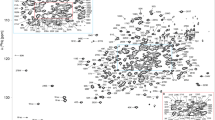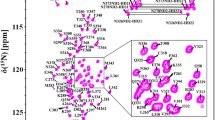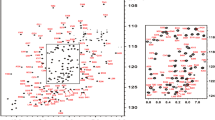Abstract
Ataxin-1 is the protein responsible for the genetically-inherited neurodegenerative disease spinocerebellar ataxia type-1 linked to the expansion of a polyglutamine tract within the protein sequence. The AXH domain of ataxin-1 is essential for the protein to function as a transcriptional co-repressor and mediates the majority of the interactions of ataxin-1 with cellular partners, mainly transcriptional regulators. One of the best characterized ataxin-1 functional partners is Capicua (CIC), a transcriptional repressor involved in signalling pathways that regulate mammalian development, tumorigenesis and, through the interaction with ataxin-1, also neurodegeneration. Complex formation of ataxin-1 with CIC is important both for the function of the wild-type protein and for pathogenesis as transcriptional disregulation is observed since the early stages of the development of the disease. Here we report the 1H, 13C and 15N backbone and side-chain chemical shift assignments of the human ataxin-1 AXH domain in complex with a CIC ligand-peptide.
Similar content being viewed by others
Explore related subjects
Discover the latest articles, news and stories from top researchers in related subjects.Avoid common mistakes on your manuscript.
Biological context
Ataxin-1 is the protein associated with the human neurodegenerative spinocerebellar ataxia type 1 or SCA1 (de Chiara and Pastore 2011; Orr et al. 1993; Zoghbi and Orr 2009). The protein belongs to the family of the so-called polyglutamine proteins, all related to neurodegeneration, in which pathogenesis is associated with the expansion of a CAG repeat tract in the coding region of the gene. Although the disease is triggered by the elongation of the polyglutamine tract, which determines protein aggregation, it is now generally accepted that the protein context may modulate this process. Indeed, regions distant in sequence from the polyglutamines and interactions with molecular partners have been shown to play a role, either positive or negative, in modifying the pathology (de Chiara et al. 2009; Masino et al. 2011). One of such regions is the AXH domain of ataxin-1, which has been shown to contribute to aggregation of the expanded and non-expanded full length ataxin-1 in cells and to be sufficient to form fibres in vitro when isolated (de Chiara et al. 2005). The AXH domain of ataxin-1 is essential for the protein to function as a transcriptional co-repressor and mediates the majority of the interactions of ataxin-1 with cellular partners, mainly transcriptional regulators. The domain, which shares an oligonucleotide-binding fold and crystallizes as a dimer of asymmetric dimers, has been shown to be predominantly dimeric in solution and in equilibrium with monomers, tetramers and higher molecular weight species (de Chiara et al. 2013). The involvement of the domain in multiple association states and the presence of an extensive asymmetry at the interface between monomers are reflected in a very complex NMR spectrum which has hampered any possibility of achieving a complete resonances assignment of the free form of the domain (de Chiara et al. 2013). Interestingly, upon interaction with the ligand-peptide from CIC (L-CICp) the AXH domain forms a monomeric 1:1 complex with an NMR spectrum indicative of a single species (Fig. 1). Here we report the practically complete assignment of the complex between human ataxin-1 AXH and CIC.
Materials and methods
Protein expression and purification
The recombinant AXH domain of human ataxin-1 (residues A567–K689) was over-expressed in the E. coli host strain BL21 (DE3) using a kanamycin-resistant pETM30 vector with a TEV-cleavable N-terminal His6-GST tag. Isotopically 15N- and 13C/15N-labelled samples were expressed in minimal (M9) medium supplemented with 15N-ammonium sulphate and 13C-glucose as the sole sources of nitrogen and carbon respectively. Purification was performed using a Ni–NTA agarose column (Qiagen) followed by FPLC size exclusion chromatography as previously described (de Chiara et al. 2003). A synthetic unlabelled ligand peptide L-CICp spanning the sequence V34-Q48 of human CIC was purchased from Pepceuticals Limited (Nottingham-UK). AXH domain and L-CICp peptide concentrations were measured by UV absorbance at 280 nm using a calculated extension coefficient of 8,480 and 5,500 M−1 cm−1, respectively.
NMR spectroscopy
NMR spectra for resonance assignments were acquired on samples containing 15N- or 15N,13C-labelled ATX1 AXH (0.5 mM) and unlabelled L-CICp (0.6 mM) (AXH:L-CICp molar ratio 1:1.2) in 20 mM Tris–HCl pH 6.85, 2 mM TCEP, 0.02 % NaN3, 8 % 2H2O. The spectra were recorded at 300 K using Varian Inova spectrometers operating at 600 and 800 MHz 1H frequency, the 800 MHz equipped with a triple resonance gradient Cold-Probe, and Bruker Avance spectrometers operating at 600 and 700 MHz 1H frequency, both equipped with triple resonance gradient CryoProbes.
All spectra were processed using NMRPipe/NMRDraw softwares (Delaglio et al. 1995) and analyzed using XEASY (Bartels et al. 1995).
Resonance assignment and Deposition
Assignment of 1H, 13C and 15N of the AXH domain bound to unlabelled L-CICp was obtained as described below. Sequence specific 1HN, 15N, 13Cα, 13Cβ and 13C assignment for the AXH were obtained using HNCA, HN(CO)CA, HNCO and HNCACB (Muhandiram and Kay 1994) in combination with a 3D 15N-edited NOESY-HSQC experiment. Assignments of the 1H and 13C resonances of AXH aliphatic and aromatic side chains were obtained from HCCH-TOCSY experiments tuned for the two distinct regions of the spectrum (Sattler et al. 1999). Aromatic sequence specific side chain assignments were achieved using (Hβ)Cβ(CγCδ)Hδ and (Hβ)Cβ(CγCδ)Hε spectra supported by the identification of main-chain/side-chain NOEs from the 13C-edited NOESY-HSQC spectrum (100 ms mixing time). The proton resonances assignment of the CIC ligand-peptide was achieved using a combination of 2D [15N,13C]-F1/F2-filtered NOESY (mixing time 100 ms) and TOCSY (Otting and Wuthrich 1990). We assigned 100 % of the HN and N, 97 % of C and 96 % of H resonances of the backbone atoms and the side chains. No residues were completely unassigned.
Secondary structure predicted on the base of the chemical shifts using Talos+ (Shen et al. 2009) and CSI (version 2.0) (Wishart and Sykes 1994) for the protein and the peptide, respectively, have been compared with those of the complex and of the X-ray structure of the free form (Fig. 2). The 1H, 13C and 15N chemical shift of the ataxin-1 AXH domain and the 1H chemical shifts of the CIC ligand peptide have been deposited into the BioMagResBank database and are available under the BMRB accession number 18982.
References
Bartels C, Xia TH, Billeter M, Guntert P, Wuthrich K (1995) The program XEASY for computer-supported NMR spectral-analysis of biological macromolecules. J Biomol NMR 6(1):1–10
de Chiara C, Pastore A (2011) Polyglutamine diseases and neurodegeneration: the example of ataxin-1. In: BrnjasKraljevic J, PifatMrzljak G (eds) In supramolecular structure and function 10. Springer, New York, pp 87–99
de Chiara C, Giannini C, Adinolfi S, de Boer J, Guida S, Ramos A, Jodice C, Kioussis D, Pastore A (2003) The AXH module: an independently folded domain common to ataxin-1 and HBP1. FEBS Lett 551(1–3):107–112
de Chiara C, Menon RP, Dal Piaz F, Calder L, Pastore A (2005) Polyglutamine is not all: the functional role of the AXH domain in the ataxin-1 protein. J Mol Biol 354(4):883–893
de Chiara C, Menon RP, Strom M, Gibson TJ, Pastore A (2009) Phosphorylation of s776 and 14-3-3 binding modulate ataxin-1 interaction with splicing factors. PLoS ONE 4(12):e8372
de Chiara C, Rees M, Menon RP, Pauwels K, Lawrence C, Konarev PV, Svergun DI, Martin S, Chen YW, Pastore A (2013) Self-assembly and conformational heterogeneity of the AXH domain of ataxin-1: an unusual example of a chameleon fold. Biophysic J 104(6):1304–1313
Delaglio F, Grzesiek S, Vuister GW, Zhu G, Pfeifer J, Bax A (1995) NMRPipe—a multidimensional spectral processing system based on UNIX pipes. J Biomol NMR 6(3):277–293
Masino L, Nicastro G, Calder L, Vendruscolo M, Pastore A (2011) Functional interactions as a survival strategy against abnormal aggregation. FASEB J 25(1):45–54
Muhandiram DR, Kay LE (1994) Gradient-enhanced triple-resonance 3-dimensional NMR experiments with improved sensitivity. J Magn Reson Ser B 103(3):203–216
Orr HT, Chung MY, Banfi S, Kwiatkowski TJ Jr, Servadio A, Beaudet AL, McCall AE, Duvick LA, Ranum LP, Zoghbi HY (1993) Expansion of an unstable trinucleotide CAG repeat in spinocerebellar ataxia type 1. Nat Genet 4(3):221–226
Otting G, Wuthrich K (1990) Heteronuclear filters in 2-Dimensional H-1, H-1 NMR-spectroscopy—combined use with isotope labeling for studies of macromolecular conformation and intermolecular interactions. Q Rev Biophys 23(1):39–96
Sattler M, Schleucher J, Griesinger C (1999) Heteronuclear multidimensional NMR experiments for the structure determination of proteins in solution employing pulsed field gradients. Prog Nucl Magn Reson Spectrosc 34(2):93–158
Shen Y, Delaglio F, Cornilescu G, Bax (2009) TALOS+: a hybrid method for predicting protein backbone torsion angles from NMR chemical shifts. J Biomol NMR 44:213–223
Wishart DS, Sykes BD (1994) The 13C chemical shift index: a simple method for the identification of protein secondary structure using 13C chemical shift data. J Biomol NMR 4:171–180
Zoghbi HY, Orr HT (2009) Pathogenic mechanisms of a polyglutamine-mediated neurodegenerative disease, spinocerebellar ataxia type 1. J Biol Chem 284(12):7425–7429
Acknowledgments
The authors thank the MRC Biomedical NMR Centre for technical support.
Author information
Authors and Affiliations
Corresponding author
Rights and permissions
Open Access This article is distributed under the terms of the Creative Commons Attribution License which permits any use, distribution, and reproduction in any medium, provided the original author(s) and the source are credited.
About this article
Cite this article
de Chiara, C., Kelly, G., Menon, R.P. et al. Chemical shift assignment of the ataxin-1 AXH domain in complex with a CIC ligand peptide. Biomol NMR Assign 8, 325–327 (2014). https://doi.org/10.1007/s12104-013-9509-z
Received:
Accepted:
Published:
Issue Date:
DOI: https://doi.org/10.1007/s12104-013-9509-z






